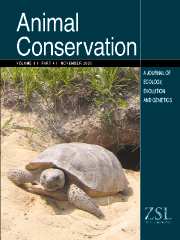Crossref Citations
This article has been cited by the following publications. This list is generated based on data provided by
Crossref.
Sibly, R. M.
Hone, J.
Clutton–Brock, T. H.
Sinclair, A. R. E.
and
Krebs, Charles J.
2002.
Complex numerical responses to top–down and bottom–up processes in vertebrate populations.
Philosophical Transactions of the Royal Society of London. Series B: Biological Sciences,
Vol. 357,
Issue. 1425,
p.
1221.
NISHI, J. S.
STEPHEN, C.
and
ELKIN, B. T.
2002.
Implications of Agricultural and Wildlife Policy on Management and Eradication of Bovine Tuberculosis and Brucellosis in Free‐Ranging Wood Bison of Northern Canada.
Annals of the New York Academy of Sciences,
Vol. 969,
Issue. 1,
p.
236.
Sinclair, A. R. E.
2003.
Mammal population regulation, keystone processes and ecosystem dynamics.
Philosophical Transactions of the Royal Society of London. Series B: Biological Sciences,
Vol. 358,
Issue. 1438,
p.
1729.
Joly, Damien O
and
Messier, François
2004.
Testing hypotheses of bison population decline (1970–1999) in Wood Buffalo National Park: synergism between exotic disease and predation.
Canadian Journal of Zoology,
Vol. 82,
Issue. 7,
p.
1165.
Bradley, Mark
and
Wilmshurst, John
2005.
The fall and rise of bison populations in Wood Buffalo National Park: 1971 to 2003.
Canadian Journal of Zoology,
Vol. 83,
Issue. 9,
p.
1195.
FULLER, JULIE A.
GARROTT, ROBERT A.
and
WHITE, P. J.
2007.
Emigration and Density Dependence in Yellowstone Bison.
The Journal of Wildlife Management,
Vol. 71,
Issue. 6,
p.
1924.
FULLER, JULIE A.
GARROTT, ROBERT A.
WHITE, P.J.
AUNE, KEITH E.
ROFFE, THOMAS J.
and
RHYAN, JACK C.
2007.
Reproduction and Survival of Yellowstone Bison.
The Journal of Wildlife Management,
Vol. 71,
Issue. 7,
p.
2365.
Fuller, Julie A.
Garrott, Robert A.
and
White, P.J.
2008.
The Ecology of Large Mammals in Central Yellowstone - Sixteen Years of Integrated Field Studies.
Vol. 3,
Issue. ,
p.
237.
Bruggeman, Jason E.
White, P.J.
Garrott, Robert A.
and
Watson, Fred G.R.
2008.
The Ecology of Large Mammals in Central Yellowstone - Sixteen Years of Integrated Field Studies.
Vol. 3,
Issue. ,
p.
217.
Sinclair, A. R. E.
and
Metzger, Kristine L.
2009.
Advances in wildlife ecology and the influence of Graeme Caughley.
Wildlife Research,
Vol. 36,
Issue. 1,
p.
8.
Colchero, Fernando
Medellin, Rodrigo A.
Clark, James S.
Lee, Raymond
and
Katul, Gabriel G.
2009.
Predicting population survival under future climate change: density dependence, drought and extraction in an insular bighorn sheep.
Journal of Animal Ecology,
Vol. 78,
Issue. 3,
p.
666.
Plumb, Glenn E.
White, P.J.
Coughenour, Michael B.
and
Wallen, Rick L.
2009.
Carrying capacity, migration, and dispersal in Yellowstone bison.
Biological Conservation,
Vol. 142,
Issue. 11,
p.
2377.
Steinmetz, Robert
Chutipong, Wanlop
Seuaturien, Naret
Chirngsaard, Erb
and
Khaengkhetkarn, Montri
2010.
Population recovery patterns of Southeast Asian ungulates after poaching.
Biological Conservation,
Vol. 143,
Issue. 1,
p.
42.
Yott, Adelle
Rosatte, Rick
Schaefer, James A.
Hamr, Joe
and
Fryxell, John
2011.
Movement and Spread of a Founding Population of Reintroduced Elk (Cervus elaphus) in Ontario, Canada.
Restoration Ecology,
Vol. 19,
Issue. 101,
p.
70.
Buhnerkempe, Michael G.
Burch, Nathanial
Hamilton, Sarah
Byrne, Kerry M.
Childers, Eddie
Holfelder, Kirstin A.
McManus, Lindsay N.
Pyne, Matthew I.
Schroeder, Greg
and
Doherty, Paul F.
2011.
The utility of transient sensitivity for wildlife management and conservation: Bison as a case study.
Biological Conservation,
Vol. 144,
Issue. 6,
p.
1808.
Jung, Thomas S.
2011.
Gray Wolf (Canis lupus) Predation and Scavenging of Reintroduced American Bison (Bison bison) in Southwestern Yukon.
Northwestern Naturalist,
Vol. 92,
Issue. 2,
p.
126.
BERGER‐TAL, ODED
BAR‐DAVID, SHIRLI
and
SALTZ, DAVID
2012.
Effectiveness of Multiple Release Sites in Reintroduction of Persian Fallow Deer.
Conservation Biology,
Vol. 26,
Issue. 1,
p.
107.
Julien, Marie-Anne
Bocherens, Hervé
Burke, Ariane
Drucker, Dorothée G.
Patou-Mathis, Marylène
Krotova, Oleksandra
and
Péan, Stéphane
2012.
Were European steppe bison migratory? 18O, 13C and Sr intra-tooth isotopic variations applied to a palaeoethological reconstruction.
Quaternary International,
Vol. 271,
Issue. ,
p.
106.
Kowalczyk, Rafał
Krasińska, Małgorzata
Kamiński, Tomasz
Górny, Marcin
Struś, Paweł
Hofman-Kamińska, Emilia
and
Krasiński, Zbigniew A.
2013.
Movements of European bison (Bison bonasus) beyond the Białowieża Forest (NE Poland): range expansion or partial migrations?.
Acta Theriologica,
Vol. 58,
Issue. 4,
p.
391.
Starns, Heath D.
Ricca, Mark A.
Duarte, Adam
and
Weckerly, Floyd W.
2014.
Climatic and density influences on recruitment in an irruptive population of Roosevelt elk.
Journal of Mammalogy,
Vol. 95,
Issue. 5,
p.
925.


